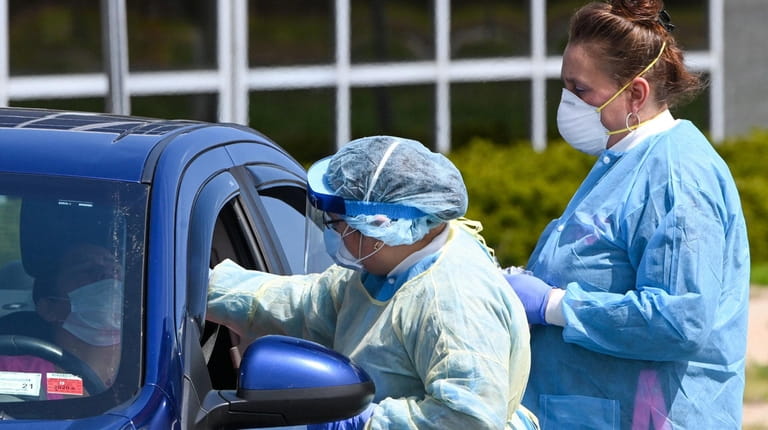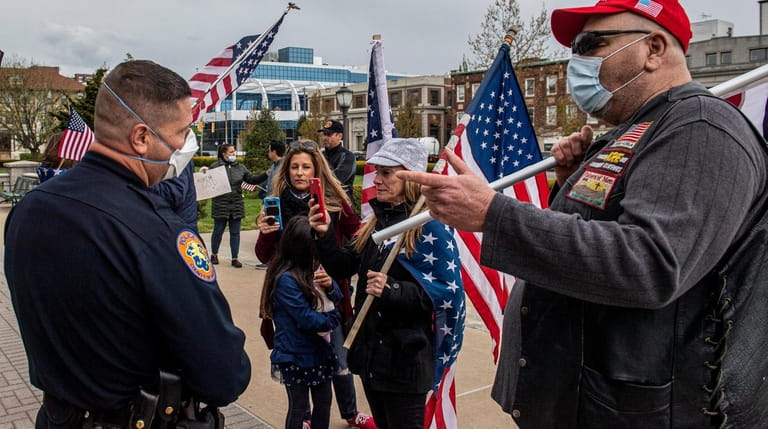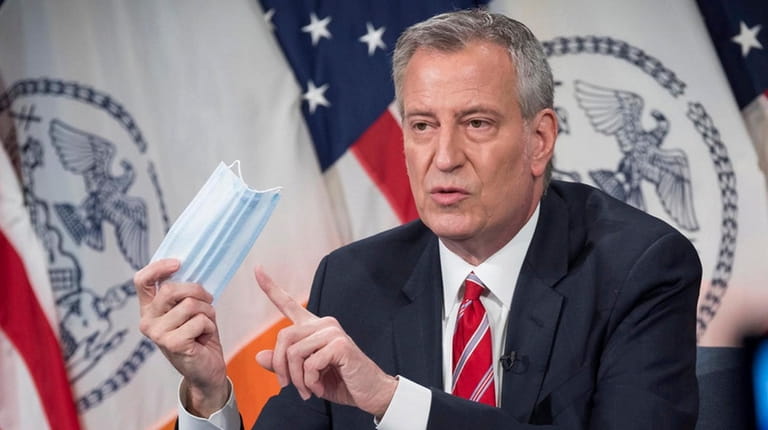Cuomo: 'Everything is closed down,' yet many staying at home made ill by virus, per NY study

This story was reported by Rachelle Blidner, Alfonso A. Castillo, Matthew Chayes, Scott Eidler, Bart Jones and David Reich-Hale. It was written by Jones.
Initial findings of a state analysis of recent hospital admissions indicate most new victims of the coronavirus are people who were mainly out of the workforce amid sweeping stay-at-home orders that shut down most of New York's economy, Gov. Andrew Cuomo said Wednesday.
The survey of nearly 1,300 COVID-19 patients admitted to hospitals the last few days generated “a surprise,” Cuomo said at his daily briefing, held at Northwell Health's Feinstein Institutes for Medical Research in Manhasset. “Overwhelmingly, the people were at home.”
The findings come after New York has taken unprecedented measures to stop the spread of COVID-19, so that as Cuomo put it: "Everything is closed down."
State officials started shutting down New York City’s subway for nightly disinfecting because they feared people were becoming infected with coronavirus while riding public transportation.
They worried that nurses, doctors and other essential workers exposed to sick patients would be primary victims of the pandemic. They already had shuttered sit-down restaurants, most stores and schools to try to curb the highly contagious virus.
The new patients who continue to show up in emergency rooms, suffering from COVID-19 illness, are mostly elderly people who are retired or unemployed, who don’t take the subway, who don’t work in hospitals or otherwise expose themselves to the virus in an obvious way.
Cuomo went on: “They’re not working, they’re not traveling, they’re predominantly downstate, predominantly minority, predominantly older, predominantly nonessential employees.”
Some 83% of the coronavirus patients were retired or unemployed, according to the survey of 1,269 COVID-19 patients at 113 hospitals. Only 17% were employed.
The findings about the persistent spread of the virus have left officials with a conundrum of how to stop its progression when many of the victims are in places health officials would not expect.
Cuomo appealed to the most affected people to keep themselves safe.
The new information, he said, reinforces the need for prevention measures.
“Much of this comes down to what you do to protect yourself," he said.
"Government has done everything it could. Society has done everything it could. Now it’s up to you. Are you wearing a mask? Are you doing the hand sanitizing? If you have younger people who are visiting you and may be out there and may be less diligent with the social distancing, are you staying away from older people?”
Much of the effort to stem the spread "comes down to personal behavior."
The past three days have seen new hospital admissions in the range of 600 to 700 people a day, well below the peak of about 3,200 but still far too many for the governor, who said he is anxious to largely stamp out the virus before lifting the restrictions.
The survey of coronavirus patients, aimed at figuring out why more cases continue to surface, found that, before they had been admitted to the hospital, 64% were generally “at home.” It said 37% were retired and 46% were unemployed.
Just 4% percent were using public transportation.
“We were thinking that maybe we were going to find a higher percentage of essential employees who were getting sick because they were going to work, that these may be nurses, doctors, transit workers,” Cuomo said. “That’s not the case.”
The survey found that 18% of the patients had been admitted to the hospital from a nursing home. The vast majority of coronavirus patients were over the age of 51.
African Americans made up 21% of the total, while Latinos accounted for 17% — far higher percentages than what they account for in the general population.
Whites made up 38% of the total, which is lower than their share of the general population.
The results have officials puzzled, because they were hoping to use the information to zero in on hot spots and targeted areas or groups.
Hot spots a concern
The governor also said that, survey results aside, one of the issues officials must deal with is the continued outbreak of coronavirus hot spots around the state.
The first one in New York and one of the first in the nation was in New Rochelle back in March, when a COVID-19-infected lawyer attended an event at a crowded synagogue. Now officials are dealing with another one in Madison and Oneida counties upstate.
While the virus has been breaking out in meat and poultry processing plants around the country, he said, the one upstate is in an agricultural business.
“It is actually a greenhouse farm, and we have dozens of cases coming from the employees in this situation,” Cuomo said. “So what does that tell you? Well, it’s not really about meat or vegetables … It is about worker density and large gatherings. That’s the caution flag here, that’s the message.”
He said that is something the state learned in New Rochelle.
“The lesson was one or two people infected who go to a large gathering or a dense gathering, that virus just takes off on you,” Cuomo said.
The survey found that most new daily admissions to hospitals due to the coronavirus are taking place in the downstate region that includes Long Island and New York City.
Nassau and Suffolk residents accounted for 18% of patients admitted to hospitals. The New York City boroughs ranged from a low of 1% of new patients in Staten Island to 21% in Manhattan.
Cuomo commented on Long Island and other parts of the region not yet meeting the requirements under state guidelines to start moving toward reopening the economy after his May 15 order shutting down nonessential businesses expires. He said local jurisdictions need to set up parallel efforts to measure the spread of the virus, limit further exposure of its residents and continue to track progress before they can reopen.
“We have to have testing in every region, Long Island, New York City, upstate" and then assemble "an army of tracers" to "isolate those people [found to have the virus], and you have to have facilities to isolate those people," Cuomo said. "We are working with regions to get that up and running.”
Cuomo: Cautious approach working
As difficult as it's been, New York State’s cautious approach to reopening amid the coronavirus pandemic is working to bring a decline of infections and hospitalizations over time, Cuomo said, while other parts of the United States are seeing an escalation of the crisis.
The virus “is on retreat in all parts of this state, which is dramatically different than the numbers for the nation,” he said. “You have states that are opening where you still are on the incline. I think that is a mistake.”
He showed on a large screen a slide with a graph from a published media report showing New York’s coronavirus case numbers steadily declining, and another graph with the rest of country minus New York. That graph showed a steady increase.
“To me that vindicates what we are doing here in New York, which says, ‘Follow the science. Follow the data. Put the politics aside and the emotion aside,’” Cuomo said.
He added: “What we are doing here shows results. The hospitalization rate is down, the number of deaths is down and the number of new cases is down.”

Women in protective garb collect samples for coronavirus testing in the parking lot of Riverhead County Center on Tuesday. Credit: James Carbone
Cuomo is implementing a slow, data-driven reopening in different phases throughout the state. That contrasts with other states that have reopened restaurants, barber shops, tattoo parlors and other businesses.
He reported a new daily death toll of 232, the sixth straight day the figure was below 300 and a sharp drop from the peak of nearly 800 a month ago. The figure has remained flat, however, the past few days, and Cuomo said the death toll is "the most distressing" news he has had to deliver day in and day out.
The number of people newly hospitalized, 601, was a significant drop from 717 announced Monday.
Cuomo still called it a “painfully slow decline,” and said he is ordering state officials to determine where the cases are occurring and figure out how to stop them.
Cuomo announced that former Google chief executive Eric Schmidt has volunteered to head a 15-member blue-ribbon committee that will help re-imagine New York’s operations after the pandemic. Schmidt, calling into the briefing via videoconferencing, said he would focus on areas such as expanding telehealth and remote learning.
Preventing a second surge
In Nassau, County Executive Laura Curran said the number of COVID-19 patients on ventilators has dropped to 254, though many face grim futures.
“The sad truth is we have to get ready for it a lot of those will not make it, and our numbers will continue to rise of those who have passed away," she said.
Curran said county officials are working with the state to study new criteria for reopening businesses and other institutions.
She said that both Nassau and Suffolk counties will need 425 new contact tracers. Nassau has close to 30 "disease detectives" that, during normal activities, work to track E. coli, hepatitis, foodborne and other types of diseases.
Nassau has seen protesters congregate outside its Mineola headquarters on several days, including Wednesday, urging the county to reopen.

Nassau police asked protesters to clear from the steps of the Theodore Roosevelt Executive and Legislative Building in Mineola on Wednesday. About two dozen called for government officials to open up New York State. Credit: Newsday/J. Conrad Williams Jr.
Suffolk County Executive Steve Bellone announced Wednesday that Suffolk hit the 14-day marker of hospital declines recommended by the U.S. Centers for Disease Control and Prevention for reopening, even though hospitalizations had risen Monday and Tuesday. On Wednesday, hospitalizations were down again by 62, to 773, the first time in weeks that hospitalizations were below 800.
“We met that marker anyway,” Bellone said, noting, “It’s not exactly how we wanted to come across the finish line.”
Suffolk reported an additional 268 COVID-19 positives, for a total of 35,543, according to state figures released Wednesday, while Nassau had 198 new positives for a total of 37,350 cases. New York City had 1,477 new cases, for a total of 178,351.
During a morning interview on WCNY's "The Capitol Pressroom" radio show, Bellone said the county is striving to meet state guidelines to prepare itself for a return to economic activity, while trying to "prevent a second surge."
Northwell Health said the number of COVID-19 patients at its 19 hospitals continues to fall. The health system said it had 1,339 coronavirus patients, a 28% drop from a week ago and a 60% drop from the peak on April 8.
Northwell said it has seen a decline every day since April 20.
Dr. Anthony Boutin, interim chief executive and president of NuHealth, the public benefit corporation that runs Nassau University Medical Center, said Wednesday that NUMC had 52 COVID-19 patients, a 74% decline from its earlier peak, a "significant achievement."
He said the hospital discharged its 565th coronavirus patient Wednesday.
NYC 'running out of money'
Reopening New York City, even once it’s epidemiologically advisable, would be stymied without a federal bailout, Mayor Bill de Blasio said Wednesday.
“We are running out of money,” de Blasio said on MSNBC's "Morning Joe."
“You can’t restart if you can’t run your city or you can’t run your state,” he said.
De Blasio has said the city is $7.4 billion in the red from lost revenue due to the shutdown. He has threatened furloughs and layoffs of municipal workers without a bailout.

New York City Mayor Bill de Blasio said the city faces dire financial straits as it tries to respond to the health emergency and plan a reopening. Credit: Mayoral Photography Office/Ed Reed
He also announced the additional streets where motor vehicles would be largely banned and opened up to pedestrians, including in the Flatiron neighborhood of Manhattan, parts of Broadway, the Garment District, the Lower East Side, Downtown Brooklyn, and several blocks of the Bronx.
MTA officials said Wednesday that the first night of their daily shutdown of the city’s subway system for deep cleaning went well. More than 700 cleaners surged the underground transit system from 1 until 5 a.m. as part of the historic shutdown — among the few times in the subway’s 116-year history it has not operated 24 hours day.
New York City Transit acting president Sarah Feinberg said most, if not all, of the subway’s fleet was disinfected, with some cars hit more than once.
Police, MTA and social service workers removed more than 2,000 homeless people from the subway system overnight. Of those, 139 accepted offers for transportation to shelters or medical facilities, MTA officials said.
New York’s COVID-19 patients
Preliminary results from 113 hospitals with survey responses from 1,269 people over three days found:
- Most new hospitalizations are largely taking place in the downstate region, with Long Island comprising 18% of cases, New York City making up about 57% of cases and Rockland and Westchester adding up to 11%.
- Minority communities were disproportionately represented among new patients, with African Americans making up 21%; Hispanics or Latinos, 17%, Asians 5% and whites 38%. Census population estimates for New York in 2019 show blacks are 18%, Latinos are 19%, Asians are 9% and whites are 55% of the state’s population.
- 66% of new COVID-19 patients were staying at home, and 18% were in nursing homes.
- Most new patients are ages 51 to 90, with 20% in the 61 to 70 age group and 19% in the 71 to 80 age group.
- 84% said not to be using public transportation or car service but are working or staying home.
- 46% of new patients said they were unemployed and 37% were retired. Only 17% remained in the workforce.
SOURCE: New York State
